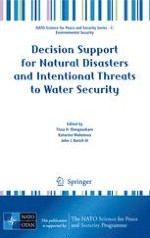2009 | OriginalPaper | Buchkapitel
Groundwater Vulnerability Assessment Using Physical Principles of Contamination Spreading
verfasst von : Peter Malik, Silvia Vojtkova
Erschienen in: Decision Support for Natural Disasters and Intentional Threats to Water Security
Verlag: Springer Netherlands
Aktivieren Sie unsere intelligente Suche, um passende Fachinhalte oder Patente zu finden.
Wählen Sie Textabschnitte aus um mit Künstlicher Intelligenz passenden Patente zu finden. powered by
Markieren Sie Textabschnitte, um KI-gestützt weitere passende Inhalte zu finden. powered by
Several methods of groundwater vulnerability assessment have been developed since 1970s in order to derive vulnerability maps, taking account of hydrogeological settings and field investigations. Majority of those relied on counting of points related to various hydrogeological factors with different, mostly subjective rating. More physical understanding to this topic was added by Brouyére et al. (2001) and Jeannin et al. (2001). Such definitions of groundwater vulnerability are based on contamination spreading principles. As the contamination evolves in the groundwater, it is affected by different intrinsic hydrodynamic and hydrodispersive mechanisms, altering progressively its spatial and temporal distribution. Main intrinsic hydrodispersive processes in underground are advection, hydrodynamic dispersion, physical retardation and dilution. For intrinsic groundwater vulnerability, three factors describing pollution by conservative contaminant are defined: contaminant transfer time, contamination duration and level of contaminant concentration. All three factors can be plotted on a “vulnerability cube” edges to help in the estimation of overall vulnerability. Such a groundwater vulnerability assessment methodology was applied at the site of the Tisovec Karst hydrogeological structure (Slovenske Rudohorie Mts., Western Carpathians — Slovakia). The potential target of contamination spreading was the groundwater table, so the final result in a map format can be called an “intrinsic groundwater resource vulnerability map” according to the “European definitions” (COST 620 project). For calculation of physically-based vulnerability parameters, the VULK software tool developed at the University of Neuchâtel in Switzerland was used. Simulations conducted using VULK tool provided contamination breakthrough curve parameters of potential contaminant transfer time, contamination duration and level of potential contaminant concentration. These were logarithmically plotted on the axes of the “vulnerability cube.” Then the resulting vulnerability value V was calculated as the distance from the “zero point” of the “vulnerability cube.” Results were used also as the first estimate of potential groundwater vulnerability influencing factors based on field data.
